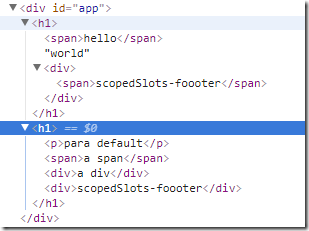Vue 测试版本:Vue.js v2.5.13
做了个 demo,把父子组件的数据都绑定到 Vue 实例 app 上,注释中的 template 相对好理解些
<div id="app"> <myele :level="level"> </myele> <child :level="level"> <p>para default</p> <span slot="span">a span</span> <div slot="div">a div</div> <div slot="footer" slot-scope="props">{{props.text}}</div> </child> </div>
window.onload = function() { Vue.component('myele', { render(createElement) { return createElement('child', { props: { level: this.level }, scopedSlots: { footer: function(props) { return createElement('div', [createElement('span', props.text)]); } } }, [createElement('span', 'hello'), 'world']); }, /* template:` <child :level="level"> <span>hello</span>world <div slot="footer" slot-scope="props"> <span>{{props.text}}</span> </div> </child> `,*/ props: ['level'] }); Vue.component('child', { render(createElement) { let nodes0 = this.$slots.default; let nodes1 = this.$slots.span; let nodes2 = this.$slots.div; let nodes3 = this.$scopedSlots.footer({ text: 'scopedSlots-foooter' }); return createElement('h' + this.level, [nodes0, nodes1, nodes2, nodes3]); }, props: ['level'] }); new Vue({ el: '#app', data: { level: 1 } }); };
效果如下:
其实最初不是这样写的,js 是这样:
window.onload = function() { Vue.component('myele', { render(createElement) { //复杂的作用域插槽单独拎出来; let scopedSlotsNode = createElement('div', { scopedSlots: { footer: function(props) { return createElement('span', props.text); } } }); return createElement('child', { props: { level: this.level } }, [createElement('span', 'hello'), 'world', scopedSlotsNode]); }, /* template:` <child :level="level"> <span>hello</span>world <div> <span slot="footer" slot-scope="props"> {{props.text}} </span> </div> </child> `,*/ props: ['level'] }); Vue.component('child', { render(createElement) { let nodes0 = this.$slots.default; let nodes1 = this.$slots.span; let nodes2 = this.$slots.div; let nodes3 = this.$scopedSlots.footer({ text: 'scopedSlots-foooter' }); return createElement('h' + this.level, [nodes0, nodes1, nodes2, nodes3]); }, props: ['level'] }); new Vue({ el: '#app', data: { level: 1 } }); };
结果报错,
半天没反应过来,后来想想,明白了,解释就在 template 里,不明白的话,再看看;
参考文档:

